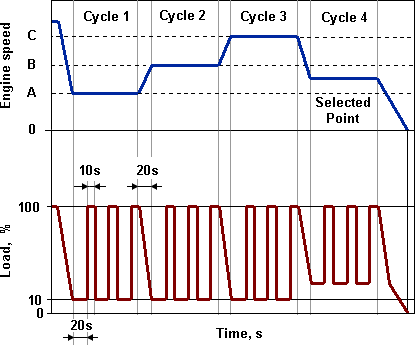European Load Response (ELR)
The European Load Response (ELR) engine test has been introduced by the Euro III emission regulation—Directive 1999/96/EC, effective year 2000—for the purpose of smoke opacity measurement from heavy-duty diesel engines [2870].
The test consists of a sequence of three load steps at each of the three engine speeds A (cycle 1), B (cycle 2) and C (cycle 3), followed by cycle 4 at a speed between speed A and speed C and a load between 10% and 100%, selected by the certification personnel. Speeds A, B, and C are defined in the ESC cycle. The sequence of dynamometer operation on the test engine is shown in Figure 1.

Smoke measurement values are continuously sampled during the ELR test with a frequency of at least 20 Hz. The smoke traces are then analyzed to determine the final smoke values by calculation. First, smoke values are averaged over 1 second time intervals using a Bessel filter veraging algorithm. Second, load step smoke values are determined as the highest 1s average value at each of the three load steps for each of the test speeds. Third, mean smoke values for each cycle (test speed) are calculated as arithmetic averages from the cycle’s three load step smoke values. The final smoke value is determined as a weighted average from the mean values at speeds A (weighting factor 0.43) , B (0.56), and C (0.01).